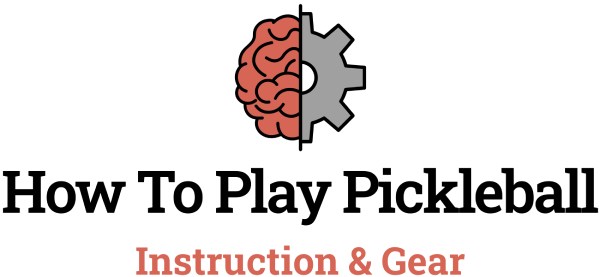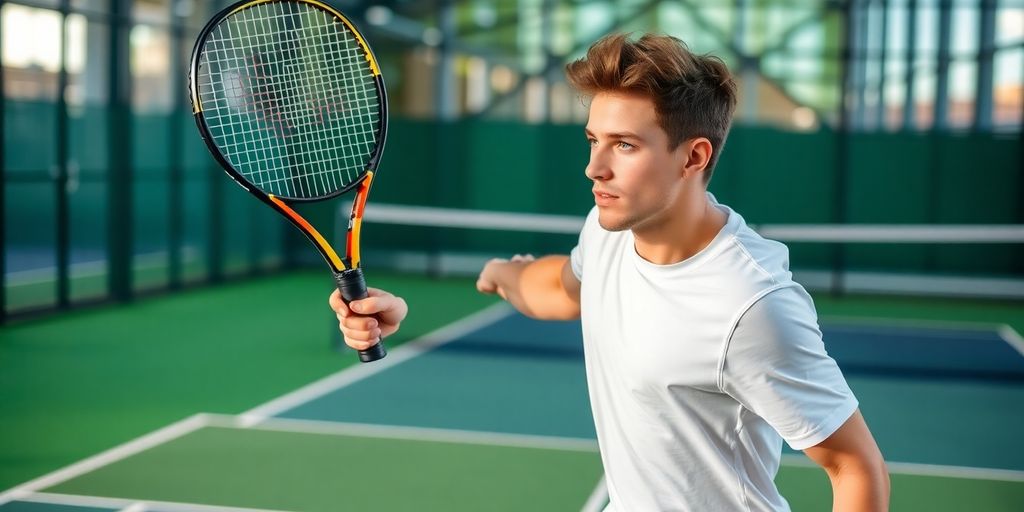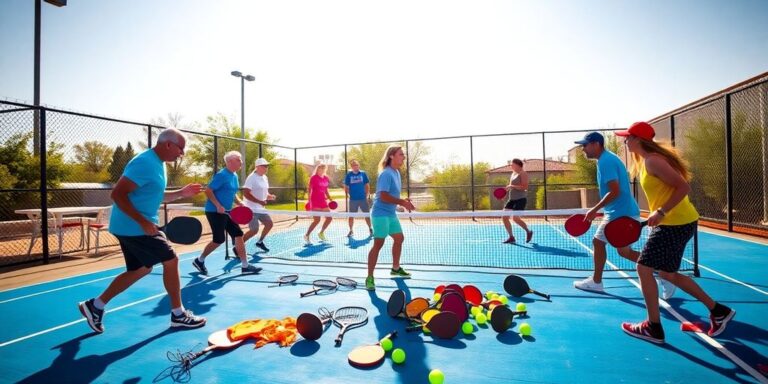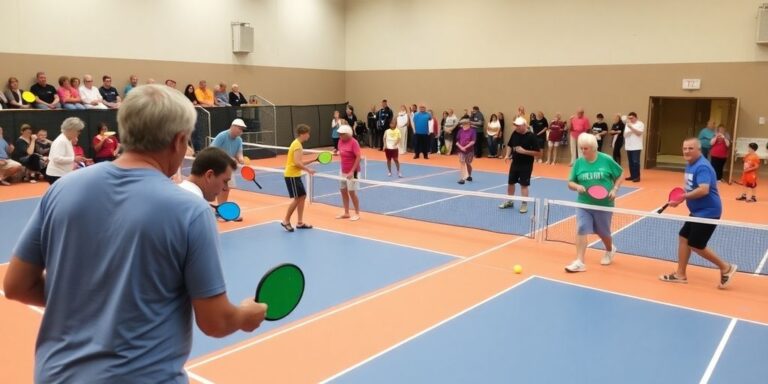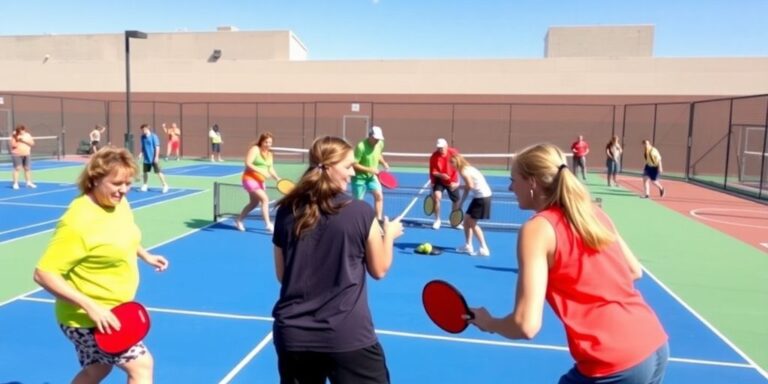Getting started with padel tennis can be a lot of fun, but it can also be a bit overwhelming. If you’re new to the game, you might be wondering where to begin. This guide is here to help you with some practical padel tennis tips that will make your experience more enjoyable and help you improve your skills on the court. Whether you’re looking to understand the basics or want to refine your techniques, we’ve got you covered with essential advice to kickstart your padel journey.
Key Takeaways
- Learn the basic rules and techniques to build a strong foundation.
- Focus on mastering essential shots like serves, volleys, and lobs.
- Develop smart strategies for positioning and reading your opponents.
- Communicate effectively with your partner for better teamwork.
- Stay positive and patient as you practice and improve your skills.
Understanding Padel Tennis Fundamentals

So, you’re diving into padel? Awesome! It’s a super fun sport, but like anything, getting the basics down is key. Think of it as building a house – you need a solid foundation before you start adding fancy stuff. Let’s break down the core elements you should focus on right away.
Learning the Rules
First things first, you gotta know the rules. Padel isn’t just tennis in a cage. The walls change everything! The scoring is similar to tennis, but how the ball interacts with the walls is unique. Get familiar with basic padel rules – how many bounces you get, when you can use the walls, and the serving rules. Trust me, knowing these will save you a lot of confusion (and maybe some arguments) on the court.
Mastering the Basic Techniques
Okay, now for the fun part: hitting the ball! Don’t worry about smashing winners right away. Focus on the basics: grip, stance, and swing. Get comfortable with both forehand and backhand shots. Consistency is way more important than power at this stage. Aim to hit the ball cleanly, right in the center of the racket. This will give you better control and help you place the ball where you want it to go. Think about it like this:
- Grip: Continental grip is common, but experiment to see what feels best.
- Stance: Be ready to move in any direction.
- Swing: Short and controlled is better than long and wild.
Developing Court Awareness
Padel is a game of angles and space. It’s not just about hitting the ball hard; it’s about knowing where to stand and where to move. Pay attention to where your partner is, where your opponents are, and where the open spaces are on the court. Court positioning is key! Think about how the walls affect the ball’s trajectory and use that to your advantage. Anticipate where the ball is going and move into position to make the next shot. It’s like a chess match, but with more running and less thinking (sometimes!).
Padel is a game of teamwork and strategy. It’s not enough to just be a good player; you need to be a good partner. Communicate with your teammate, cover the court effectively, and work together to exploit your opponents’ weaknesses. Remember, two heads are better than one!
Essential Padel Shot Techniques
Alright, let’s talk shots. You can have all the strategy in the world, but if you can’t execute, you’re toast. Padel is about precision, not just power, so let’s break down some key techniques.
Serve and Return
The serve in padel isn’t about blasting an ace every time. It’s more about placement and setting up the point. Think about it like this: a good serve puts your opponents on the defensive right away. The return is equally important. A solid return can neutralize a good serve and put you in control of the rally.
Here’s a few things to keep in mind:
- Aim for consistency over power on your serve.
- Vary your serve placement to keep your opponent guessing.
- Focus on getting the return deep and cross-court.
Mastering the Volley
Volleys are huge in padel, especially at the net. You need quick reactions and soft hands. Don’t try to kill every volley; instead, focus on placement and keeping the ball in play. A well-placed volley can force errors or set up easy winners. If you want to improve your basic shots, focus on the volley.
- Keep your racket head up and your grip firm but relaxed.
- Meet the ball out in front of your body.
- Use your legs to generate power, not just your arm.
Executing Effective Lobs
The lob is your best friend when you’re in trouble or need to reset the point. A good lob can buy you time to recover position or force your opponents off the net. It’s a defensive shot that can turn into an offensive weapon if executed well. It’s also a great way to counter aggressive net play. If you are playing competitive play, the lob is a must.
The lob is more than just a high shot; it’s a tactical tool. Use it to disrupt your opponents’ rhythm, create space, and change the pace of the game. Don’t be afraid to use it often, especially when you’re under pressure.
Here are some tips for hitting better lobs:
- Get under the ball and use your legs to lift it.
- Aim for a high arc that lands deep in the court.
- Add some topspin to make the ball bounce away from your opponents.
Improving Your Game Strategy
Positioning on the Court
Court positioning is super important. It’s not just about standing somewhere; it’s about being in the right place at the right time. Beginners often make the mistake of standing too far back or bunching up with their partner. The goal is to cover as much of the court as possible while leaving minimal gaps for your opponents to exploit. Think of it like a dance – you and your partner need to move in sync to control the space. Understanding padel court positioning can really change your game.
Reading Your Opponent
This is where padel becomes a mental game. It’s not enough to just hit the ball; you need to anticipate what your opponents are going to do. Watch their body language, their preferred shots, and their weaknesses. Do they always go for the smash? Do they struggle with lobs? Once you identify these tendencies, you can adjust your strategy accordingly. It’s like playing chess – you’re always thinking a few moves ahead. Here are some things to look for:
- Weak Hand: Do they favor one side? Exploit the other.
- Movement: Are they slow to the net? Use drop shots.
- Shot Selection: Do they telegraph their shots? Anticipate their next move.
Utilizing Wall Play
The walls are your friends! Seriously, they can be a huge asset if you know how to use them. Instead of panicking when the ball bounces off the wall, see it as an opportunity to set up your next shot. Practice your wall play so you can confidently return those tricky shots. It’s all about anticipation and timing. You can use the walls to your advantage in a few ways:
- Defensive Play: Use the wall to buy yourself time to recover.
- Offensive Play: Surprise your opponents with unexpected angles.
- Strategic Lobs: Bounce the ball off the wall to create a difficult lob.
Mastering wall play can really set you apart from other players. It adds a whole new dimension to the game and forces your opponents to think differently. Don’t underestimate the power of the walls!
Remember, improving your game strategy takes time and practice. Don’t get discouraged if you don’t see results immediately. Keep working on these skills, and you’ll gradually become a more strategic and effective player. It’s all about improving your padel game one step at a time.
Building Effective Communication with Your Partner

Communication in padel is super important, especially when you’re playing doubles. It’s not just about hitting the ball; it’s about working together as a team. If you and your partner are on the same page, you’ll be way more effective on the court. Let’s get into how to make that happen.
Establishing Roles
Before you even step onto the court, talk with your partner about who’s going to cover what. Decide who’s better at the net and who’s stronger at the back. This helps avoid confusion and ensures you’re not both going for the same shot. It’s like assigning positions in any team sport – everyone needs to know their job. This is especially important when you’re trying to master pickleball doubles.
Encouraging Each Other
Padel can be intense, and everyone makes mistakes. Instead of getting frustrated, focus on supporting your partner. A simple "Nice try!" or "You’ll get the next one!" can make a big difference. A positive attitude can really boost morale and help you both play better. Remember, you’re a team, and lifting each other up is part of the game. It’s all about maintaining a positive mindset.
Developing Signals
Sometimes, you need to communicate without saying a word. Develop a few simple hand signals with your partner to indicate things like who’s taking the next shot or which direction you’re planning to move. This can be especially useful in fast-paced situations where verbal communication might be difficult. Think of it as your secret code to coordinate effectively.
Good communication minimizes confusion and maximizes your team’s efficiency, ultimately leading to better performance. It’s not just about calling out "mine" or "yours"; it’s about anticipating each other’s moves and working together seamlessly.
Here’s a simple example of signals you could use:
| Signal | Meaning |
|---|---|
| Tap on head | I’m going for the lob |
| Point to net | I’m moving to the net |
| Thumbs up | I’m covering the back of the court |
Maintaining a Positive Mindset
Padel can be tough, no doubt about it. It’s easy to get down on yourself after a bad shot or a lost point. But honestly, how you handle those moments can make or break your game. It’s not just about skill; it’s about staying positive and keeping your head in the game, even when things get rough. Let’s face it, everyone makes mistakes. It’s part of learning. The key is to not let those mistakes derail you.
Learning from Mistakes
Okay, so you messed up a shot. Big deal. Don’t dwell on it. Instead, take a second to figure out what went wrong. Was your positioning off? Did you swing too hard? Once you identify the issue, you can actively work on correcting it. Think of each mistake as a free lesson. It’s a chance to improve, so embrace it. I find it helpful to keep a little mental checklist during games. If I keep hitting the net, I remind myself to lift the ball more. Simple adjustments can make a huge difference.
Staying Composed Under Pressure
Pressure situations are part of the game. Maybe it’s match point, or you’re down a few games. Whatever it is, staying calm is key. When you get tense, your muscles tighten up, and your shots suffer. Try to focus on your breathing. Take a few deep breaths to relax. Remember your game plan, and stick to it. Don’t try to do anything fancy or out of the ordinary. Just play your game, one point at a time.
Fostering Team Spirit
If you’re playing doubles, a positive attitude is even more important. Your mood affects your partner, and vice versa. Encourage each other, even after mistakes. A simple "good try" or "next one" can go a long way. Celebrate your partner’s good shots, and offer support when they’re struggling. Effective communication is the backbone of any good partnership, but a positive attitude is the glue that holds it all together. A supportive environment can boost morale and improve overall performance.
I remember one match where my partner and I were down big. We started getting frustrated with each other, and our game completely fell apart. Then, we decided to just focus on having fun and supporting each other. We didn’t win, but we played much better, and we left the court feeling good about our effort. It’s a reminder that attitude is everything.
Practicing Consistently for Improvement
It’s easy to get excited when you start playing padel, but remember that improvement comes with time and effort. Don’t expect to become a pro overnight. Consistent practice is the key to seeing real progress. Let’s look at how to make the most of your practice sessions.
Setting Realistic Goals
Start by setting small, achievable goals. Instead of aiming to win every match, focus on improving one specific aspect of your game each week. For example, you might work on your serve and return accuracy or your wall play. Breaking down your goals into smaller steps makes the process less overwhelming and more rewarding. Here’s an example of how you might structure your goals:
- Week 1: Improve serve placement by 10%.
- Week 2: Increase successful volleys by 5%.
- Week 3: Reduce unforced errors during wall play by 15%.
Incorporating Drills
Drills are a fantastic way to focus on specific skills and build muscle memory. There are tons of padel drills you can do on your own or with a partner. Here are a few ideas:
- Wall Volley Drill: Practice volleying against a wall, focusing on control and consistency.
- Serve and Return Drill: Work on your serve placement and your return shots.
- Cross-Court Rally Drill: Practice hitting cross-court shots with a partner, focusing on accuracy and depth.
Remember to vary your drills to keep things interesting and challenge yourself in different ways. Don’t just stick to what you’re already good at; push yourself to improve your weaknesses.
Tracking Your Progress
Keeping track of your progress is a great way to stay motivated and see how far you’ve come. You can use a simple notebook, a spreadsheet, or even a dedicated app to record your practice sessions and track your performance. Note things like the number of successful serves, the percentage of volleys you make, and the number of unforced errors you commit. Reviewing your progress regularly will help you identify areas where you’re improving and areas where you still need to focus your efforts.
Choosing the Right Equipment
Okay, so you’re getting into padel. Awesome! But before you start smashing winners, let’s talk gear. Having the right equipment can actually make a big difference in your game, especially when you’re just starting out. It’s not just about looking cool (though that’s a bonus, right?). It’s about comfort, performance, and preventing injuries. Let’s break it down.
Selecting the Right Racket
The racket is your most important tool. Choosing the right one can feel overwhelming, but it doesn’t have to be. Here’s what to consider:
- Shape: Diamond, teardrop, or round. Diamond is power-focused, teardrop is a mix, and round is control-oriented. Beginners usually do better with round or teardrop shapes.
- Weight: Lighter rackets are easier to maneuver, which is great when you’re still learning. Heavier rackets offer more power, but can be tiring.
- Material: Graphite, carbon fiber, or fiberglass. Graphite and carbon fiber are stiffer and more expensive, offering more power and control. Fiberglass is more flexible and forgiving, good for beginners. You can find some top padel rackets that fit your needs.
Understanding Padel Balls
Padel balls look a lot like tennis balls, but they’re slightly smaller and have less pressure. This makes them bounce lower and move slower, which suits the smaller court. Using the right balls is important for a good game. Here’s the deal:
- Pressure: Padel balls have lower pressure than tennis balls. Make sure you’re buying balls specifically labeled for padel.
- Durability: Some balls lose pressure faster than others. Cheaper balls might be okay for casual play, but if you’re playing regularly, invest in better quality balls. It might be worth exploring pickleball training equipment too, as some drills overlap.
- Testing: A good test is to drop the ball from shoulder height. It should bounce between 50 and 65 cm.
Investing in Proper Footwear
Don’t underestimate the importance of good shoes! Padel involves a lot of quick lateral movements, and you need shoes that can handle it. Regular running shoes just won’t cut it. Here’s what to look for:
- Grip: Look for shoes with a herringbone pattern on the sole. This provides excellent grip on the court surface.
- Support: Ankle support is key to preventing injuries. Choose shoes that fit snugly and provide good stability.
- Cushioning: Padel can be tough on your joints, so good cushioning is important for comfort and injury prevention. If you’re on a budget, consider lightweight padel rackets first, then save up for good shoes.
Choosing the right equipment is an investment in your game and your health. Don’t rush the process. Try out different rackets, test different balls, and find shoes that fit well and provide good support. It might take some time, but it’s worth it in the long run. You’ll be playing better and enjoying the game more. And that’s what it’s all about, right?
When it comes to picking the right gear, it’s important to think about what you really need. Whether you’re starting a new hobby or upgrading your tools, choosing the right equipment can make a big difference. Don’t forget to check out our website for helpful tips and guides that can help you make the best choice!
Wrapping It Up
So there you have it! Padel tennis is a fun sport that mixes skill, strategy, and teamwork. By focusing on the basics, working on your court positioning, and communicating well with your partner, you can really step up your game. Don’t forget to keep a positive attitude, even when things get tough. Mistakes are just part of the learning process. With practice and these tips in mind, you’ll not only improve but also enjoy your time on the court even more. Now, grab your racket, find a buddy, and get out there to play some padel!
Frequently Asked Questions
What is padel tennis?
Padel tennis is a fun sport that combines elements of tennis and squash. It is usually played in doubles on a smaller, enclosed court.
How do you score in padel tennis?
Scoring in padel is similar to tennis. You can score points when your opponents fail to return the ball or hit it out of bounds.
What equipment do I need to start playing padel?
To play padel, you need a padel racket, padel balls, and comfortable athletic shoes. Proper gear can help improve your game.
How can I improve my padel skills?
You can improve by practicing regularly, focusing on basic techniques, and playing matches with different partners to gain experience.
What are some basic techniques I should learn?
Start with mastering the grip, stance, and swings for forehand and backhand shots. Learning to serve and return effectively is also important.
Is padel tennis suitable for beginners?
Yes, padel tennis is great for beginners! It’s easy to learn, and the smaller court makes it more accessible for new players.
